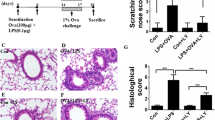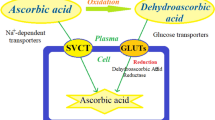Abstract
It has been suggested that bradykinin may play a role in stimulating cough in at least one pathological condition in humans. We have employed an animal model to investigate the possible role of this peptide in irritant-induced cough. The kinin antagonist Hoe 140 and codeine both produced dose-related inhibition of cough responses to inhalation of citric acid or bradykinin aerosols by conscious guinea pigs. The selective tissue kallikrein inhibitor CH694 inhibited cough caused by citric acid but not by bradykinin. Indomethacin pretreatment attenuated the responses to both stimuli as did phosphoramidon. It is concluded that cough produced by citric acid inhalation may be mediated, at least in part, by generation of kinins; secondary to this, a release of prostanoids also appears to participate in the response.
Similar content being viewed by others
References
Belvisi MG, Chung KF, Jackson DM, Barnes PJ (1988) Opioid modulation of non-cholinergic neural bronchoconstriction in guinea-pig in vivo. Br J Pharmacol 95:413–418
Chakravarty NK, Matallana A, Jensen R, Borison HL (1956) Central effects of antitussive drugs on cough and respiration. J Pharmacol Exp Ther 117:127–135
Choudry NB, Fuller RW, Pride NB (1989) Sensitivity of the human cough reflex: effect of inflammatory mediators; prostaglandin E2, bradykinin and histamine. Am Ref Respir Dis 140:137–141
Christiansen SG, Proud D, Cochrane CG (1987) Detection of tissue kallikrein in the bronchoalveolar lavage fluid of asthmatic subjects. J Clin Invest 79:188–197
Clay TP, Thompson MA (1985) Irritant induced cough as a model of intrapulmonary airway reactivity. Lung 163:183–191
Corrao WM, Braman SS, Irwin RS (1979) Chronic cough as the sole presenting manifestation of bronchial asthma. N Engl J Med 300:633–637
Featherstone RL, Hutson PA, Holgate ST, and Church MK (1988) Active sensitization of guinea-pig airways in vivo enhances in vivo and in vitro responsiveness. Eur J Respir Dis 1:839–845
Fuller RW, Dixon CMS, Cuss FMC, Barnes PJ (1987) Bradykinin induced bronchoconstriction in humans. Am Rev Respir Dis 135:176–180
Geiger R, Kellerman J, Deutzmann R, Lottspeich F (1987) Biochemistry of human tissue (urinary) kallikrein. In: Vasodepressor Hormones, Birkhauser Verlag, Basel, pp 223–237
Geppetti P, Maggi CA, Peretti F, Frilli S, Manzini S (1988) Simultaneous release by bradykinin of substance P and calcitonin gene related peptide immunoreactivity from capsaicin sensitive structures in guinea-pig heart. Br J Pharmacol 94:288–290
Greenburg R, Osman GH, O'Keefe EH, Antonaccio MJ (1979) The effect of captopril (SQ14,255) on bradykinin induced bronchoconstriction in the anaesthetised guinea-pig. Eur J Pharmacol 57:287–294
Greg I (1977) The role of infection. In Clark JH, Godfrey S (eds) Asthma, Chapman and Hall, London, pp 161–163
Ichinose M, Barnes PJ (1990) The effect of peptidase inhibitors on bradykinin induced bronchoconstriction in guinea-pigs in vivo. Br J Pharmacol 101:77–80
Johnson AR, Ashton J, Schulz WW, Erdos EG (1985) Neutral metalloendopeptidase in human lung tissue and cultured cells. Am Rev Respir Dis 132:564–568
Karlsson J-A, Zackrisson C, Forsberg K (1989) Inhibition of ACE and enkephalinase potentiate irritant-induced bronchoconstriction but not cough in conscious guinea-pig (abstract). Br J Pharmacol 96:158pp
Lu W, Okamura T, Bian K, Inatomi A, Toda N. (1988) Prostaglandins involved in contractions by angiotensin II and bradykinin of isolated dog sphincter pupillae. Br J Pharmacol 95:545–551
McEwan JR, Choudry NB, Fuller RW (1990) The effect of sulindac on the abnormal cough reflex associated with dry cough. J Pharmacol Exp Ther 255:161–164
McEwan JR, Choudry NB, Street R, Fuller RW (1989) Change in cough reflex after treatment with enalapril and rarnipril. Br Med J 299:13–16
Naclerio RM, Proud D, Lichtenstein LM, Kagey-Sabotka A, Hendley JO, Sorrentino J, Gwaltney JM (1988) Kinins are generated during expeimental rhinovirus colds. J Infect Dis 157:133–145
Naclerio RM, Proud D, Peters SP, Silber G, Kagey-Sabotka A, Adkinson NF, and Lichtenstein LM (1986) Inflammatory mediators in nasal secretions during induced rhinitis. Clin Allergy 16:101–110
Perkins MN, Forster PL, Dray A (1988) The involvement of afferent nerve terminals in the stimulation of ion transport by bradykinin in rat isolated colon. Br J Pharmacol 94:47–54
Pounsford JC, Birch MJ, Saunders KE (1985) Effect of bronchodilators on the cough response to inhaled citric acid in normal and asthmatic subjects. Thorax 40:662–667
Regoli D, Barabe J (1980) Pharmacology of bradykinin and related kinins. Pharmacol Rev 32:1–46
Riordan MF, Beardsmore CS, Brooke AM, and Simpson H (1994) Relationship between respiratory symptoms and cough receptor sensitivity. Arch Dis Child 70:299–304
Salem H, Aviado DM (1966) Antitussive drugs with special reference to a new theory for the initiation of the cough reflex and the influence of bronchodilators. Am J Med Sci 247:585–600
Saria A, Martling C-M, Yan Z, Theodorsson-Norheim E, Gamse R, Lundberg JM (1988) Release of multiple tachykinins from capsaicin sensitive sensory neurones in the lung by bradykinin, histamine, dimethylphenyl piperazinium and vagal nerve stimulation. Am Rev Respir Dis 137:1330–1335
Stockwell M, Lang S, Yip R, Zintel T, White C, Gallagher CG (1993) Lack of importance of the superior laryngeal nerves in citric acid cough in humans. J Appl Physiol 75:613–617
Szelke M, Evans DM, Jones DM International patent Application WO 92/04371 (GB priority date 07.09.90)
Szelke M, Evans DM, Jones DM, Fawcett L, Ashworth D, Olsson H, Featherstone RL, Church MK (1994) Synthetic inhibitors of tissue kallikrein: effects in vivo in a model of allergic inflammation. Brazilian J Med Res 27:1943–1947
Varley JG, Perring S, Seminario M-C, Flemming J, Holgate ST, Church MK (1991) Aerosol deposition in the guiea-pig: a comparison of two methods of exposure (abstract). Am Rev Respir Dis 143:708
Warren JB, Ritter JM, Hickling NE, Barrow SE (1987) Bradykinin stimulated prostaglandin synthesis in conscious rabbits. Br J Pharmacol 92:895–900
Webb D, Benjamin N, Collier J, Robinson B (1986) Enalapril-induced cough. Lancet 2:1094
Widdicome JG (1954) Respiratory reflexes from the trachea and bronchi of the cat. J Physiol (Lond) 123:55–70
Wirth K, Hock FJ, Albus U, Linz W, Alpermann HG, Anagnostopoulous H, Henke S, Breipohl G, König W, Knolle J, Schölkens BA (1991) Hoe 140; a new potent and long acting bradykinin antagonist: in vivo studies. Br J Pharmacol 102:774–777
Author information
Authors and Affiliations
Additional information
Offprint requests to: R. L. Featherstone
Rights and permissions
About this article
Cite this article
Featherstone, R.L., Parry, J.E., Evans, D.M. et al. Mechanism of irritant-induced cough: Studies with a kinin antagonist and a kallikrein inhibitor. Lung 174, 269–275 (1996). https://doi.org/10.1007/BF00173141
Accepted:
Issue Date:
DOI: https://doi.org/10.1007/BF00173141




